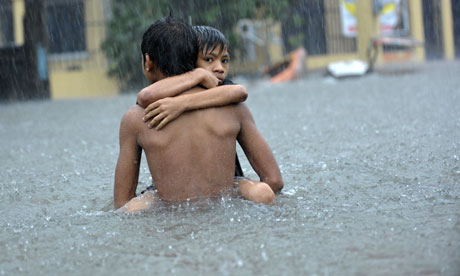Cutting greenhouse gases will be no quick fix for our weather, scientists say
UK study predicts increased floods and droughts will continue for decades after global temperatures are stabilised

Global warming will continue to bring havoc to the world's weather systems for decades after reductions are made in greenhouse gas emissions, a new study shows.
Scientists at the Met Office Hadley Centre in Exeter say climate change could bring greater disruption to the planet's water cycle than previously thought.
The research suggests that increased floods and droughts could continue long after future efforts to stabilise temperature may succeed.
Vicky Pope, head of climate change advice at the Hadley Centre, said: "We can't say that if we manage to bring down our carbon dioxide emissions then we don't need to worry any more. There will still be changes beyond that point."
A team led by Peili Wu used a computer model to analyse how the Earth's water cycle could react to changes in future amounts of carbon dioxide in the atmosphere.
It found that once carbon dioxide levels rise to a high level, even sharp reductions fail to prevent longlasting impacts on snow and rainfall.
This is down to accumulated heat in the oceans, which dissipates slowly and drives changes in the water cycle as it does so.
Writing in a paper to be published in the journal Geophysical Research Letters, the scientists say: "Our results suggest that relationships between precipitation and warming may significantly underestimate precipitation changes during periods of [greenhouse gas] stabilisation or reduction.
"The inertia due to the accumulated heat in the ocean implies a commitment to changes long after stabilisation."
They add: "This effect must be taken into account when assessing the implications of various mitigation options for flooding, water supply, food production and human health."
The study simulated the effects of a steady rise in carbon dioxide levels until the equivalent atmospheric concentration topped 1,000 ppm (parts per million).
The current CO2 level is just over 390 ppm, and most policies aimed at tackling climate change suggest the world should not exceed 450-550 ppm, though this would require significant curbs on carbon pollution.
In the study, the scientists then rapidly brought the CO2 level back down to pre-industrial levels of around 280 ppm.
In practice, this would be impossible – without geo-engineering techniques that could actively remove it from the atmosphere – but the scientists wanted to see what would theoretically happen.
The model showed that, while temperatures dropped sharply as CO2 was reduced, the disruption to precipitation continued for several decades.
How the rainfall may change for a particular region is a more complicated question, though the scientists said their model suggested significant drying in South America, Southern Africa and Australia.
Link: http://www.guardian.co.uk/environment/2010/jun/17/cutting-emissions-not-fix-water-cycle







No comments:
Post a Comment